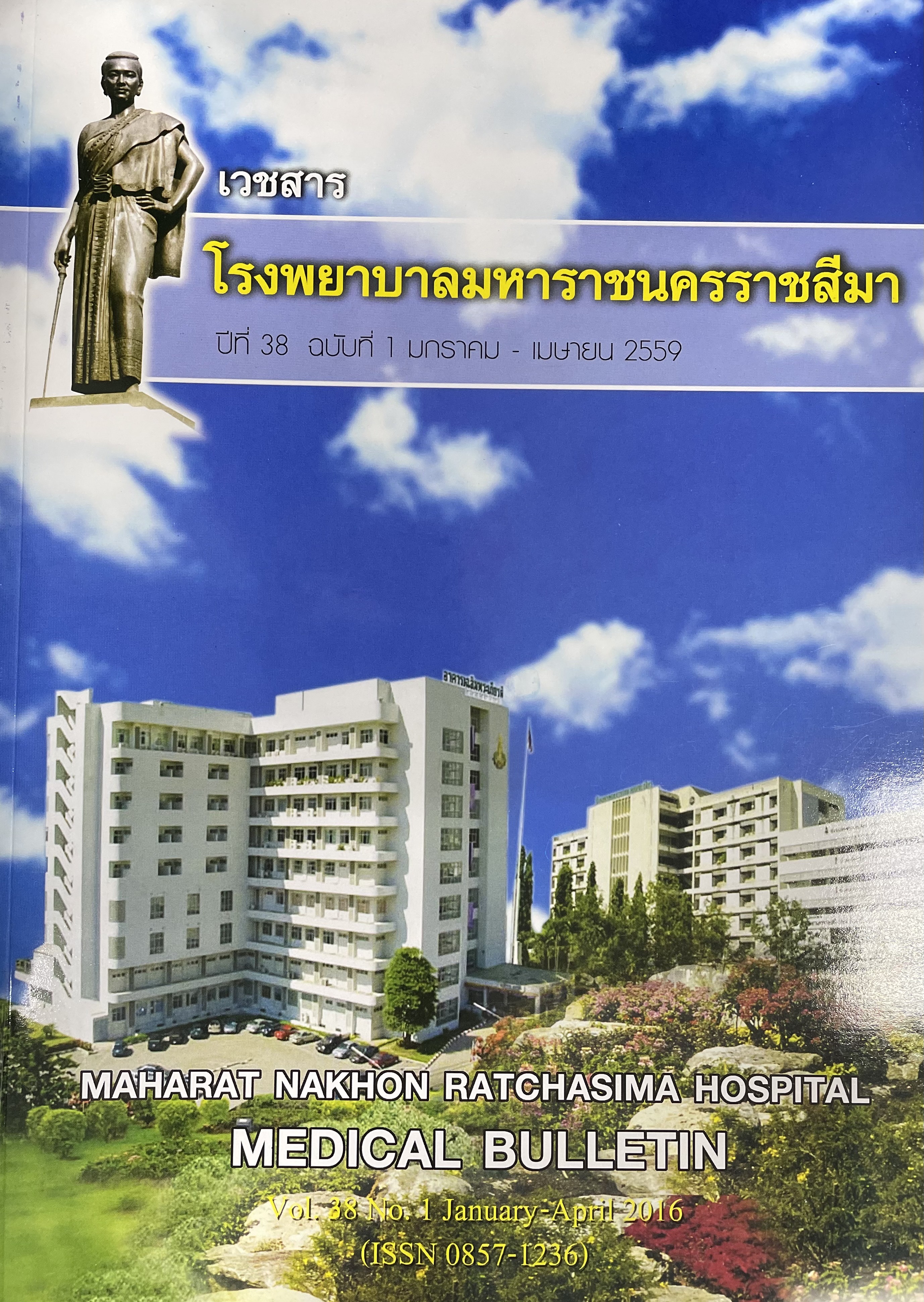การเปรียบเทียบประสิทธิผลของการใส่ท่อช่วยหายใจชนิด Laryngeal mask airway (LMA) ด้วยยา Propofol และ ยา Lidocaine เปรียบเทียบกับการให้ยา Propofol เพียงตัวเดียว
Main Article Content
บทคัดย่อ
Propofol เป็นยานำสลบใช้ในการใส่ท่อช่วยหายใจชนิด Laryngeal mask airway (LMA) โดยไม่ใช้ยาหย่อนกล้ามเนื้อ เนื่องจากยา Propofol มีคุณสมบัติในการกด Airway reflex และมีการนำคุณสมบัติของยา Lidocaine มาเสริมช่วยเพิ่มประสิทธิผลในการใส่ท่อช่วยหายใจให้ดียิ่งขึ้น ขนาดยา Propofol ที่เหมาะสมในการใส่ Laryngeal mask airway (LMA) มีขนาดตั้งแต่ 2.5-3 mg/kg ซึ่งถ้าใช้ยา Propofol ในขนาดที่ต่ำที่สุด คือ ขนาด 2.5 mg/kg เพียงตัวเดียวเปรียบเทียบกับการลดขนาดยา Propofol ลงเหลือเพียง 2.0 mg/kg โดยมีการใช้ยา Lidocaine ร่วมด้วยทั้งการให้แบบ Topical และแบบ Intravenous ว่าวิธีใดจะมีประสิทธิผลมากที่สุดและ เกิดภาวะไม่พึงประสงค์น้อยที่สุด วิธีการศึกษา: เป็น Prospective double blind control study ในผู้ป่วยที่มารับการ ผ่าตัดแบบไม่เร่งด่วน อายุ 18-65 ปี ASA I-II และ วิสัญญีแพทย์เลือกใช้การใส่ท่อช่วยหายใจชนิด Laryngeal mask airway (LMA) แบ่งผู้ป่วยเป็น 3 กลุ่ม กลุ่มละ 50 คน กลุ่ม P หมายถึง ให้ยา Propofol 2.5 mg/kg, กลุ่ม TL-P หมายถึง ให้ยา Propofol 2 mg/kg ร่วมกับให้ยา Lidocaine spray 40 mg พ่นที่บริเวณ posterior pharyngeal wall นำไปก่อน 3 นาทีและกลุ่ม IVL-P หมายถึง ให้ยา Propofol 2 mg/kg ร่วมกับให้ยา Lidocaine ทาง Intravenous 1.5 mg/kg นำไปก่อน 3 นาที และจะประเมิน jaw opening, coughing, gagging, body movement, ภาวะ laryngospasm และภาวะ apnea ผลการศึกษา: อุบัติการณ์การเกิด gagging, body movement ทั้งช่วงขณะใส่และหลังใส่ Laryngeal mask airway (LMA) มากที่สุดในกลุ่ม IVL-P (P value < 0.05) เมื่อเปรียบเทียบ optimal insertion กลุ่ม IVL-P พบมีอุบัติการณ์น้อยที่สุด (P value = 0.018) สรุป: การให้ยา Topical lidocaine 40 mg ร่วมกับยา Propofol 2 mg/kg มีประสิทธิผลใกล้เคียงกับการให้ยา Propofol 2.5 mg/kg ในการใส่ท่อช่วยหายใจชนิด Laryngeal mask airway (LMA) โดยเกิดภาวะแทรกซ้อนไม่ต่างกัน
Article Details

อนุญาตภายใต้เงื่อนไข Creative Commons Attribution-NonCommercial-NoDerivatives 4.0 International License.
เอกสารอ้างอิง
Stoneham MD. Facilitation of laryngeal mask insertion. Effects of lignocaine given intravenously before induction with propofol. Anesthesia 1995; 50: 464-6.
Cook TM. Lignocine to aid the insertion of the laryngeal mask airway with thiopentone. A comparison between topical and intravenous administration. Anesthesia 1996; 51: 787-90.
Seavell CR. Topical lignocaine and thiopentone for the insertion of a laryngeal mask airway. A comparison with propofol. Anesthesia 1996; 51: 699-701.
Changchien CF. Topical lidocaine improves conditions for laryngeal mask airway insertion. Can J Anesth 2010; 57: 446-52.
Gharaei B, Jafari A. Topical versus intravenous lidocaine in children with upper respiratory infection undergoing anesthesia: A randomized, double blind, clinical trial. Anesth Pain Med 2015; 5(4): e23501.
Erb TO, von Ungern-Sternberg BS. The effect of intravenous lidocaine on Laryngeal and respiratory reflex responses in anaesthetized children. Anaesthesia 2013; 68: 13-20.
Asai T, Morris S. The laryngeal mask airway: its features, effects and role. Can J Anesth 1994; 41:930-60.
Staikou C, Paraskeva A. Intravenous lidocaine does not affect the anesthetic depth during rapid sequence induction and intubation as assessed by Bispectral Index monitoring : a randomized double blind study. Arch Med Sc 2013; 9: 713-8.
Yukioka H, Yoshimoto N. Intravenous lidocaine as a suppressant of coughing during tracheal intubation. Anesthesia Analgesia 1985; 64: 1189-92.
Goh PK, Chiu CL. Randomized double-blind comparison of ketamine-propofol, fentanyl-propofol and propofolsaline on haemodynamics and laryngeal mask airway insertion conditions. Anaesth Intensive Care 2005; 33: 223-8.

